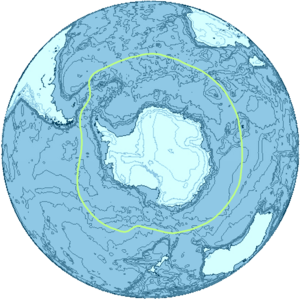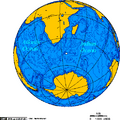Antarctic facts for kids
The Antarctic is the area around the Earth's South Pole. It is opposite the Arctic region which is around the North Pole. The Antarctic includes the continent of Antarctica and the ices, waters and islands in the Southern Ocean.
Wildlife
A variety of animals live in Antarctica for at least some of the year, including:
- Seals
- Penguins
- South Georgia pipits
- Albatrosses
- Antarctic petrels
- Whales
- Fish, such as Antarctic icefish, Antarctic toothfish
- Squid, including the colossal squid
- Antarctic krill
Most of the Antarctic continent is permanently covered by ice and snow, leaving less than 1 percent of the land exposed. There are only two species of flowering plant, Antarctic hair grass and Antarctic pearlwort, but a range of mosses, liverworts, lichens and macrofungi.
Conservation
The Antarctic hosts the world's largest protected area comprising 1.07 million km2, the South Georgia and the South Sandwich Islands Marine Protection Area created in 2012. The latter exceeds the surface area of another vast protected territory, the Greenland National Park’s 972,000 km2. (While the Ross Sea Marine Protection Area established in 2016 is still larger at 1.55 million km2, its protection is set to expire in 35 years.)
Time zones
Because Antarctica surrounds the South Pole, it is theoretically located in all time zones. For practical purposes, time zones are usually based on territorial claims or the time zone of a station's owner country or supply base.
Images for kids
-
The Antarctic Plate
-
The Antarctic (without its periphery of unattached sea ice, a composite satellite image)
-
At the Port of Ushuaia, Argentina there is the Antarctic Unit
-
Moubray Bay and Mount Herschel, Eastern Antarctica
-
The Amundsen–Scott South Pole Station, the geographic South Pole is signposted in the background
-
Ushuaia, Argentina is the most active gateway to Antarctica
-
Grytviken Museum in South Georgia
See also
 In Spanish: Región antártica para niños
In Spanish: Región antártica para niños











